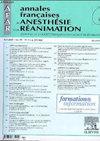Syndrome de défaillance respiratoire aiguë sévère au cours d’un syndrome thoracique aigu chez une enfant drépanocytaire de 8 ans : bénéfice potentiel de l’association précoce échange transfusionnel et décubitus ventral
Abstract
We report the case of an 8-year-old sickle cell anemia child admitted for acute respiratory failure complicating acute chest syndrome. Because of threatening respiratory failure, tracheal intubation was performed immediately after ICU admission. The patient met the criteria for ARDS with a PaO2/FiO2 ratio of 94 mmHg. An exchange transfusion was performed immediately after admission. HbS fraction failed from 69 % to 30 %. Fluid resuscitation with crystalloids and continuous norepinephrine infusion was needed because of arterial hypotension. Due to persistent severe hypoxemia with PaO2/FiO2 ratio below 100, the patient was placed in prone positioning 16 hours after admission, for a total duration of 14 hours. A second 12-hour session of prone positioning was performed 41 h after admission and PaO2/FiO2 ratio reached 300 mmHg after. Treatment also included transfusion of two red-cell pack on day 1 and 2 after admission in order to maintain hemoglobin level above 8 g/dL, and a daily folic acid supplementation. The control of hyperthermia was achieved by a systematic parenteral administration of paracetamol. Cefotaxime and erythromycine were continued until day 7 despite the negative results of all bacteriological samples. The outcome was favorable from day 3 and the patient met the criteria for extubation on day 5. A first attempt of extubation was performed on day 5, but re-intubation was required because of laryngeal edema. Steroids were given for 48 h and the patient was successfully extubated on day 7. She was discharged from the ICU on day 8, and from the hospital on day 12. We discuss the various treatments available for the management of acute chest syndrome and their actual relevance in acute respiratory distress syndrome in the absence of strong evidence-based guidelines in pediatric ARDS.

 求助内容:
求助内容: 应助结果提醒方式:
应助结果提醒方式:


